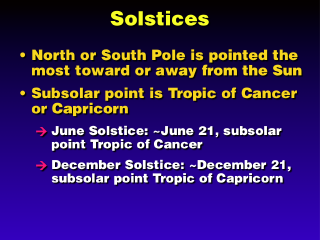
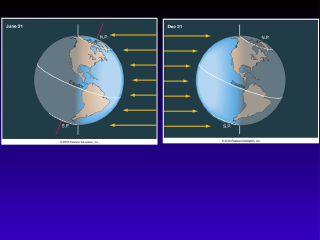


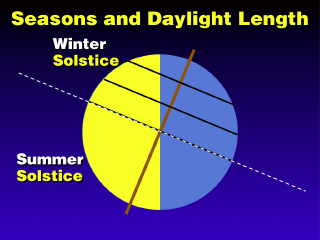
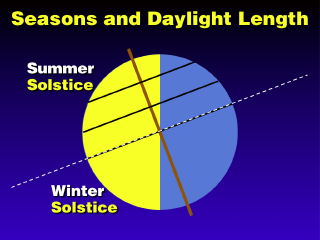
This diagram shows the distribution of sunlight on Earth for one of the Solstices (summer solstice in the Northern Hemisphere, to be precise). A Solstice occurs when the sun is directly overhead a point most north or south of the Equator (in other words, the sun is directly over the Tropic of Cancer or Capricorn). Note that one-half of the Earth is illuminated at all times, but the amount of each hemisphere illuminated may vary due to the Earth's tilt.
To get the amount of daylight vs. night, we note that the Earth rotates once every 24 hours. So a point on any latitude circle takes 24 hours to go all the way around and back to the same point. Thus, we can estimate the number of daylight hours by figuring out the fraction of the latitude circle in daylight vs. darkness and taking that portion of 24 hours. For example, the middle of the latitude circles illustrated is about 3/8 in light and 5/8 in darkness. 3/8 of 24 is 9, so there are 9 hours of daylight.
At the Equator, even at the Solstice, there appears to be 12 hours of daylight and 12 hours of night. So for any tilt less than 90 degrees, the daylight time at the Equator is always the same as the nighttime all year round.
Note also that there is a region
around each pole that is either completely in light or completely in dark. These
polar regions have 24 hours of either light or dark on dates near the Solstices.
The Arctic Circle (in the Northern Hemisphere; in the Southern Hemisphere,
it would be the Antarctic Circle) is the latitude circle that encompasses the
region where 24 hours of day/night occurs. With the Earth tilted 23.5 degrees,
this latitude is 90 degrees - 23.5 degrees = 67.5 degrees latitude.

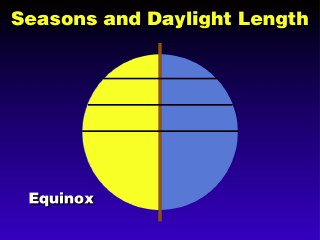
At the Equinox (March and September, around the 20th), the Earth is oriented so that both the Northern and Southern Hemispheres are exactly half-illuminated by the sun (this is because the sun is directly over the Equator). So the length of daylight equals the length of night everywhere on these dates (except the poles, where the sun is skimming around the horizon all day long).
The tilt of the Earth does not affect this relationship of the sun's illumination. The Earth's rotation axis would be tilted within a plane that is perpendicular to this diagram, so no matter what the tilt, half of each latitude circle would be in light and half in darkness.